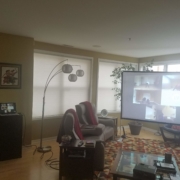Reluctant Innovation
By Suchitra Sairam
04/09/2020
COVID-19. Global Pandemic. Not many characters, but they say so much.
There are many words being used to describe these times we are in – whatever euphemisms we use, things are just so…. strange. Unfamiliar. Uncomfortable. What is “normal” now? What will “normal” be? No doubt, there are more questions than answers right now. Even though this time and situation has been foisted upon us without invitation, it has been an opportunity to truly examine and reflect on what we value, and why-what-how-when we do things. Perhaps nature’s way of making us reflect on these things.
Generally speaking, I do not shy away from creativity, from new ideas on how to solve problems, from innovations – for those are all cornerstones of things I love; art, science, engineering, business, crafts. However, I have shied away from the use of technology (beyond audio playback) in how I have gone about learning, practicing, and teaching during my 35-year journey in Bharatanatyam and allied arts.
I have told myself many stories around this.
“Video is a crutch – great for jogging the memory, but not so great to learn from; you miss the essence, the detail, the humanity of our movement.”
“Online teaching is sterile – and the time lags for video and audio make it impossible to teach effectively, and to make sure students get the corrections they need.”
“I can’t tell if someone is off talam if there is a time lag.”
“There is no way to give individual attention to students in an online group class.”
And on and on – you get the drift.
I have been fortunate that I have not HAD to use any of these methods thus far. Now with #StayHomeMN for the collective good of our community, there has been no option but to find a way to “Make it work,” as Tim Gunn would say. The age-old saying, “Necessity is the mother of innovation,” comes to life.
So…. What do you do?
So, after a lot of thinking about what I thought would be effective, what I had the capacity to do, and testing capabilities with several enthusiastic and willing students ready to learn and experiment with me, Kala Vandanam has adopted a combination of shorter group classes online with submitted video assignments – then students who submit their video homework can schedule a 15 minute 1×1 with me to work on corrections specific to them so they can move forward in their practice. This is supplemented by video learning tools I have created, along with more Open Adavu Class sessions during the week for students to keep movement and practice in their lives while we are all safely at home.
I was ready to make a big commitment to make things work, but wanted to structure it in such a way that encouraged students to put in their work also; virtual hands reaching toward each other.
I asked myself, with everything that people have on their minds as we all adjust to these new circumstances, is all of this worth it?
What does this look like?

I am just technically savvy enough to be dangerous. I knew I’d be unsatisfied with what I could see on my laptop screen – so I ordered a projector, portable screen, a portable Bluetooth speaker, and a 20′ long, fat HDMI cable to get everything hooked up. The only thing I haven’t done yet is a wireless mike… might become necessary soon.
Since my studio is not equipped with Wi-Fi, all of this has to happen in my condo living room. We do the best that we can.
So, after monkeying around with different setups and options, including rearranging furniture, I’ve settled into a set up that works, including barstools to hold my notebook, thattukazhi kuchi/palakai, and other accouterments for the class. (see below)
None of this was cheap – maybe technology purchases I had planned for the future, but not things I was expecting to spend on right now. So one has to ask… is this expense worth it?
And…. How does this feel?
This is, unquestionably, SIGNIFICANTLY more time and work for me – to conduct group classes, to create video tools, to review multiple videos from each student, note their corrections to prep for their 1x1s, have their 1x1s, and so forth. But if it keeps the momentum and learning moving forward, if it keeps us connected while giving us all some sense of “normalcy”, then maybe it is worth it.
It is also much more tiring. As an example, as part of my normal teaching schedule, I usually teach 9 hours of group classes on Sundays, with two 15-minute breaks – and while I am tired after that, I am not exhausted. With the shortened group class schedule, I find myself COMPLETELY WIPED OUT after only 5 hours of group classes, interspersed with FOUR 15-minute breaks.
Why is this? I’m guessing it is because I don’t get any energy back from a screen when I normally get so much energy back from students when we are in class. I feel like I am talking to myself when we have to mute everyone else on screen to avoid audio disruptions. Sometimes, there isn’t enough bandwidth, and people disappear from the video even if they are still in the web meeting room – when you can’t see OR hear them, it is a little disconcerting. But I trust that this experience is still of value, because students have been wonderfully responsive to this approach.
Many are willingly coming to Virtual Open Adavu Class 2-3 times a week outside of their group class, wanting to stretch and sweat it out. Many are taking this opportunity to do every homework assignment (maybe even more regularly than in the past). Many have made a lot of progress in these short weeks since we last saw each other in person the week of March 8. Many have expressed that they are so glad that they get to dance, even if we can’t dance together.
Then…. What does this mean?
While I don’t see myself ever making this a primary vehicle to teach once we have this pandemic behind us, I can see myself adopting some of this into our approach at Kala Vandanam. During “normal” times, commutes are a real challenge for people during the week – so if some of these methods we are working with during these times work, then how can I incorporate that into weeknight practice for students? Maybe it is something that looks like “Office Hours” or “Review Sessions” or “Adavu Practice.” Now that I have HAD to teach this way, I am now at least more open to WANTING to teach this way – in part, at least.
So has this Reluctant Innovation been worth it? As they say in Minnesota, YOU BETCHA.



